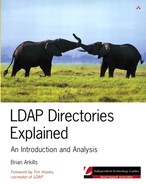LDAP recently celebrated its tenth birthday. For comparison, that's about the same age as the World Wide Web, half as old as the domain naming system, and around a third as old as the Internet itself. In its relatively short life, LDAP has grown from its obscure roots as an easier way to access the X.500 directory into the Internet standard for directories, used by virtually every e-mail client, browser, and a host of other applications, with more being developed every day. Like any successful technology, LDAP has taken on a life of its own, being used in ways its designers never imagined. I, for one, never thought when helping to design LDAP ten years ago that it would be used in the diversity of applications that it is today.
When I started work on LDAP, my ambitions were much smaller. I was simply trying to solve a problem on my own campus at the University of Michigan. I wanted to give desktops across the campus access to the central university-wide directory, which was based on X.500. This desire led to the creation of a protocol similar to LDAP called DIXIE. The popularity of DIXIE among a small community of similarly minded directory developers led to my joining forces with Steve Kille and Weng Yeong and to the creation of a standard version in LDAP.
LDAP's breakthrough to the mainstream, so to speak, came in 1996 when Netscape galvanized the industry around adopting LDAP as the Internet's commercially accepted directory protocol. Soon, all major vendors were on board, announcing plans to develop their own LDAP implementation, and LDAP was on its way to being a part of most users' everyday computing lives.
Often people that use LDAP are not even aware they are using it. It is the protocol used to access your corporate e-mail directory; LDAP may be consulted every time you access a private Web page; LDAP often stores configuration for the services you access. In these applications and others, LDAP provides the behind-the-scenes support needed to control access to resources and look up information. LDAP has also been used for applications ranging from storing and retrieving images to calculating chess moves.
In this book Brian Arkills has put together a broad treatment of LDAP for readers of varying technical backgrounds. It should prove useful to those seeking a more accessible introduction to the topic than has been previously available. As for me, I look forward to seeing what the next ten years will bring for LDAP.
Timothy A. Howes, Ph.D.Opsware Inc.Co-creator of LDAP
